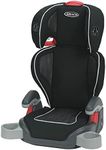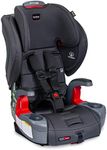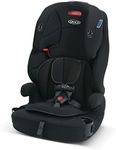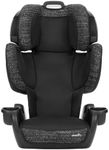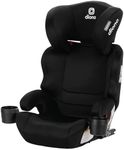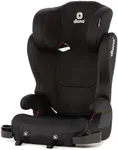Buying Guide for the Best Narrow Booster Car Seat
Choosing a narrow booster car seat is all about finding a safe, comfortable, and space-saving solution for your child, especially if you need to fit multiple car seats in your vehicle or have a compact car. The right booster seat should provide proper belt positioning, be easy to install, and fit well in your car. It's important to consider your child's age, height, and weight, as well as how the seat will work with your vehicle's layout. Always check that the seat meets safety standards and is appropriate for your child's stage of growth.Width of the SeatThe width of a booster car seat refers to how much space it takes up across the back seat of your car. This is especially important if you need to fit more than one car seat or have a smaller vehicle. Narrow seats are typically under 18 inches wide, while standard seats can be wider. If you need to fit three seats across or have limited space, look for the narrowest options. If space is not a concern, a slightly wider seat may offer more comfort. Always measure your car's back seat before choosing.
Type of Booster (High-Back vs. Backless)Booster seats come in two main types: high-back and backless. High-back boosters provide head and neck support and help position the seat belt correctly, making them a good choice for younger children or cars without headrests. Backless boosters are more compact and easier to move between vehicles, but they require your car to have a proper headrest. Choose a high-back booster if your child still needs extra support or if your car's seats are low. Opt for a backless booster for older children who are ready and if you need maximum portability.
Weight and Height LimitsEach booster seat has specific weight and height limits that indicate the range of child sizes it can safely accommodate. These limits are important for safety, as using a seat outside its recommended range can reduce its effectiveness. Lower limits usually start around 30-40 pounds and 38-40 inches, while upper limits can go up to 100-120 pounds and 57 inches. Choose a seat that matches your child's current size and allows room for growth, but never use a seat if your child is below the minimum or above the maximum limits.
Seat Belt PositioningProper seat belt positioning is crucial for your child's safety. A good booster seat will guide the vehicle's seat belt so it sits correctly across your child's shoulder and lap. Some boosters have adjustable belt guides or clips to help with this. If your car's seat belt doesn't fit your child well with a particular booster, try another model. Always check that the belt lies flat across the upper thighs and shoulder, not the stomach or neck, to ensure maximum protection.
Ease of Installation and UseA booster seat should be easy to install and use every day. Some seats have features like LATCH connectors to keep them in place when not in use, while others simply rest on the seat. Consider how often you'll need to move the seat between cars and whether you want features like removable covers for easy cleaning. If you'll be switching cars frequently, look for a lightweight, simple design. If the seat will stay in one car, installation features may be more important.
Comfort FeaturesComfort features include padding, armrests, cup holders, and adjustable headrests. These can make longer rides more pleasant for your child. More padding and adjustable features are great for frequent or long trips, while a basic seat may be fine for short rides. Think about your child's preferences and how much time they'll spend in the seat when deciding which comfort features matter most.
Safety CertificationsAll booster seats sold must meet minimum safety standards, but some may have additional certifications or pass extra tests. Look for labels indicating compliance with your country's safety regulations. If you want extra peace of mind, check for seats that have been tested for side-impact protection or have received high safety ratings from independent organizations. Always prioritize safety certifications to ensure your child is protected.
